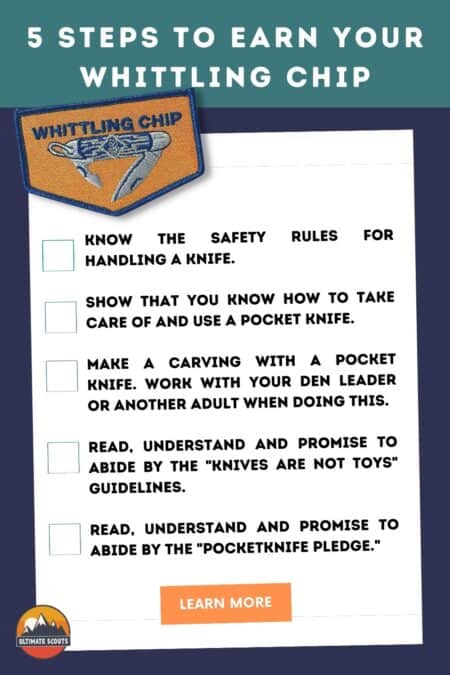Pocket Knife Safety – Earning Your Whittling Chip
Pocket Knife Safety - Earning Your Whittling Chip
Cub Scout Whittling Chip Requirements
In this post you will learn all about knife safety for kids, how to care for your pocket knife, recommended pocket knives that a parent can feel safe as their child uses, as well as a printable and quiz that you can use to help with your lessons on pocket knife safety. The information will help in completing the requirements for Bear Claws and earning the much desired Whittling Chip.
What Are The Cub Scout Whittling Chip Requirements?
- Know the safety rules for handling a knife.
- Show that you know how to take care of and use a pocket knife.
- Make a carving with a pocket knife. Work with your den leader or another adult when doing this.
- Read, understand and promise to abide by the “Knives Are Not Toys” guidelines.
- Read, understand and promise to abide by the “Pocket Knife Pledge.”
What Are The Safety Rules For Using A Pocket Knife?
- A knife is a tool, not a toy.
- Know how to sharpen a knife.
- A sharp knife is safer because it is less likely to slip and cut you.
- Keep the blade clean.
- Never carry an open pocketknife.
- When you are not using your knife, close it and put it away.
- Keep your knife dry.
- When you are using the cutting blade, do not try to make big shavings or chips. Easy does it.
- Make a safety circle: Before you pick up your knife to use it, stretch your arm out and turn in a circle. If you can’t touch anyone else, it is safe to use your knife
Knife Safety Basics Videos
How To Take Care Of And Use A Pocket Knife
Knives can last a very long time as long as they are well taken care of. There are 4 actions you can do to keep your knife in good shape. You will want to keep it sharp, clean, lubricated, and tight.
How To Safely Clean A Knife?
You will want to clean your knife frequently so that dirt and debris don’t get into the folding mechanism. To clean a knife all you will need is some soapy water and an old toothbrush. Clean the knife and brush out any debris that my have built up in the small grooves and moving parts of the knife. Be sure to let it dry completely so it doesn’t rust.
How To Safely Sharpen A Knife?
When it comes to sharpening a knife it can get pretty complicated with sharpening stones and having to hold the knife at a certain angle but for kids learning how to sharpen knives I personally like to keep it simple and safe.
The safest way I recommend kids sharpening their knife is using a handheld sharpener. It will protect their hands and the angle is already set for them. My kids use this exact one which came highly recommended. If you don’t like to purchase online I believe we bought it at Walmart. If that one is a little busy for you we also have this one that sits in our kitchen drawer and I use it on all of our knives, even the kitchen ones.
How To Safely Lubricate A Knife?
First, you will want to decide if your child is careful enough to lubricate the knife or if a parent should do it. As with all of the steps in taking care of a knife an adult should be present but oiling a knife makes me a little more nervous than cleaning it.
Before lubricating the pocket knife you will want to make sure it is clean of all debris. Using an oil designed for knives, (do not use cooking oils, WD-40, etc.) you will want to place drops of oil in the joint areas and along the knife. The video below shows the steps used when lubricating the knife.
Note*- The oil does cause the knife to no longer be food safe
How To Safely Tighten A Knife?
Keeping a blade tight and not wiggling or coming out of the handle is very important. Different knives will have different ways of keeping it tight so you will want to research the pocket knife your child is using and find the best way to tighten up the blade.
What Kind Of Knife To Use?
There are so many options for pocket knives out there that it can be overwhelming. An ideal knife for your child is going to be a folding, lock-blade pocket knife with a short blade. If you are like me you are very nervous with your child having a knife for the first time even if they have earned their Whittling Chip. I researched knives and found 3 that I would be comfortable letting my child use and carry.
1. Camillus Camlite
I like that it has a textured handle so it is less likely to slip out of a kids hand. It locks into place with the lock release on the back of the knife instead of the front where your fingers are right where the blade comes down. It also says it has 440 stainless steel and carbonitride titanium bonded blade which is 10x stronger than untreated steel. The last thing I liked was that there was a screw that I could easily tighten if the blade became loose.
2. Opinel Outdoor Junior No. 7
I am not an expert on knives just the parent of kids who have purchased a few dozen knives and the biggest problem I found is they would pick out “cool looking” knives that were cheaply made and within a day of use the blade was loose and I just didn’t trust how safe the knife was. I came across the Opinel knives and was super impressed.
They have been around since 1890 when they were first made in the French Alps and to his day they are still manufactured in France. I trust in a business that specializes in a product and have been around for over a hundred a years. I also really like that the tip is a bit rounded and the unique locking mechanism makes me feel more comfortable as a child opens and closes the knife. It comes in a few color options which is fun.
3. Cub Scout Pocket Knife
This is a smaller size knife with rubber grip that has a lock-back that makes for a great starter knife for kids. It also has the scout logo on it which is fun for the kids.
Make A Carving With A Pocket Knife
I have watched through dozens of YouTube videos to try and find something age appropriate for the kids to watch and learn about whittling from and I have not found much that were truly beginner based for kids.
I did find some great soap carving videos that use plastic knives, so maybe start out with soap carving using their pocket knives and then move on to wood carving. I did this with my group and found that this bar soap works the best. You can probably find it at your local dollar store as well.
Carve A Rocket Out Of Soap
Teaching Children To Whittle
10 Simple Whittling Projects
Supplies Needed For Whittling
Depending on the lessons you are going to teach here are a few resources of items you may want to have on hand.
1. Bar Soap
2. Bass Wood Blocks
3. Cut Resistant Gloves For Kids
What Are The "Knives Are Not Toys" Guidelines?
- Close the blade with the palm of your hand.
- Never use a knife on something that will dull or break it.
- Be Careful that you do not cut yourself or any person nearby.
- Never use a knife to strip the bark from a tree.
- Do not carve your initials into anything that does not belong to you.
What Is The "Pocketknife Pledge"?
In return for the privilege of carrying a pocketknife to designated Cub Scout functions, I agree to the following:
- I will treat my pocket knife with the respect due a useful tool.
- I will always close my pocketknife and put it away when not in use. I will not use my pocket knife when it might injure someone near me. I promise never to throw my pocket knife for any reason.
- I will use my pocket knife in a safe manner at all times.
Where Do You Put The Whittling Chip?
The Cub Scout Whittling Chip Patch is a temporary patch. It does not get permanently sewn onto the uniform. It can be hung from a temporary patch holder on the right pocket
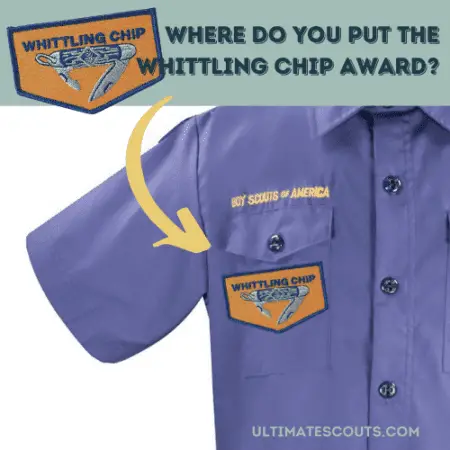
The Cub Scout Whittling Chip is a card to be carried in the scouts pocket. I highly recommend laminating it so it will withstand the frequent use (and it will survive accidentally going through the washing machine 🙂 )
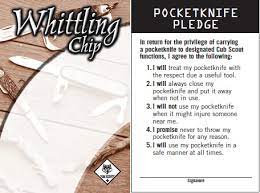
Whittling Chip Printable
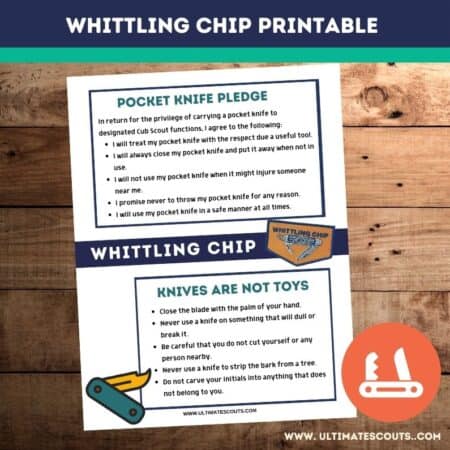
We have made a Whittling Chip Printable to help your Bear Scouts study the Pocket Knife Pledge and the Knives Are Not Toys rules.
For those of you who are not in scouts this still makes for a great lesson on teaching your kids about pocket knife safety.
Whittling Chip Quiz
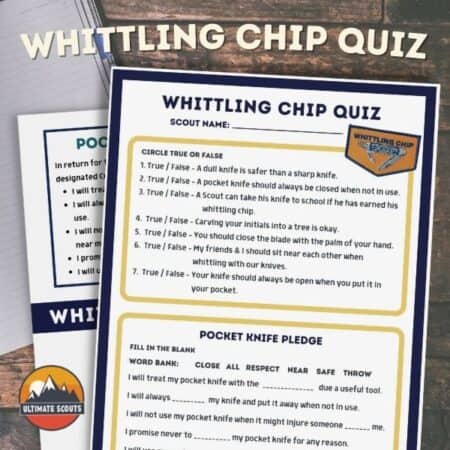
An instant downloadable pdf file to test how much the kids have learned about pocket knife safety. The Whittling Chip Quiz comes with an answer sheet to make it easier for you to check their work.

